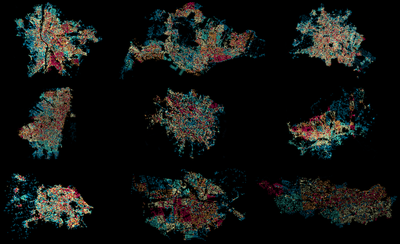Urban Analytics Lab

About us
We are introducing innovative methods, datasets, and software to advance data-driven urban planning, digital twins, and geospatial technologies in establishing and managing the smart cities of tomorrow. Converging multidisciplinary approaches inspired by recent advancements in computer science, geomatics and urban data science, seasoned with a touch of crowdsourcing and open science, we conceive cutting-edge techniques for urban sensing and analytics at the city-scale. Watch the video above or read more here.
We are proudly based at the Department of Architecture at the College of Design and Engineering of the National University of Singapore, a leading global university centered in the heart of Southeast Asia. We are also affiliated with the Department of Real Estate at the NUS Business School.
News
Updates from our group
Featured publications
For the full list of publications see here.

Urban road networks (URNs) are ubiquitous and essential components of cities. Visually, they present diverse patterns that embody latent planning principles. However, we still lack a global insight into such patterns. In this paper, we propose a scalable deep learning-based framework to automate accurate and multiscale classification of road network patterns in cities and present a comprehensive global implementation on 144 major cities around the world, yielding their multiscale pattern profiles and urban fabrics, highlighting both similarities and contrasts. We observe significant disparities across continents and regions, particularly at larger scales. We give particular attention to exploring inter-city pattern similarities with new metrics we introduce, and uncover subgroups in each continent, unveiling the potential intercontinental dissemination of planning paradigms. We establish four modes of intra-city spatial distribution of patterns considering diversity and clustering. Notably, radial road networks are found to be positively correlated with GDP per capita and negatively correlated with PM2.5 pollution. Our global study provides a new perspective to understand the URN texture of cities, which helps to understand the externalities of different road patterns and accordingly promote scientific and sustainable solutions for urban development.

Street View Imagery (SVI) is crucial in estimating indicators such as Sky View Factor (SVF) and Green View Index (GVI), but (1) approaches and terminology differ across fields such as planning, transportation and climate, potentially causing inconsistencies; (2) it is unknown whether the regularly used panoramic imagery is actually essential for such tasks, or we can use only a portion of the imagery, simplifying the process; and (3) we do not know if non-panoramic (single-frame) photos typical in crowdsourced platforms can serve the same purposes as panoramic ones from services such as Google Street View and Baidu Maps for their limited perspectives. This study is the first to examine comprehensively the built form metrics, the influence of different practices on computing them across multiple fields, and the usability of normal photos (from consumer cameras). We overview approaches and run experiments on 70 million images in 5 cities to analyse the impact of a multitude of variants of SVI on characterising the physical environment and mapping street canyons: a few panoramic approaches (e.g. fisheye) and 96 scenarios of perspective imagery with variable directions, fields of view, and aspect ratios mirroring diverse photos from smartphones and dashcams. We demonstrate that (1) disparate panoramic approaches give different but mostly comparable results in computing the same metric (e.g. from R=0.82 for Green View to R=0.98 for Sky View metrics); and (2) often (e.g. when using a front-facing ultrawide camera), single-frame images can derive results comparable to commercial panoramic counterparts. This finding may simplify typical processes of using panoramic data and also unlock the value of billions of crowdsourced images, which are often overlooked, and can benefit scores of locations worldwide not yet covered by commercial services. Further, when aggregated for city-scale analyses, the results correspond closely.

The visual landscape plays a pivotal role in urban planning and healthy cities. Recent studies of visual evaluation focus on either objective or subjective approach, while describing the visual character holistically and monitor its evolution remains challenging. This study introduces an embedding-driven clustering approach that integrates both physical and perceptual attributes to infer the spatial structure of the visual environment, and investigates its spatio-temporal evolution. Singapore, a highly urbanised yet green city, is selected as a case study. Firstly, a visual feature matrix is derived from street view imagery (SVI). Then, a graph neural network is constructed based on road connections to encode visual features and spatial dependency leading to a clustering algorithm that is used to discover the underlying characteristics of the visual environment. The implementation characterises streetscapes of the city-state into six types of clusters. Finally, taking advantage of historical SVI, a longitudinal analysis reveals how visual clusters have evolved in the past decade. Among them, one of the clusters represents high-density visual experience, affirming the work as such streetscape dominates the central business district and it is evolving elsewhere, mirroring the expansion of new towns. In turn, another identified cluster, indicating sparse landscapes, decreased, while areas that are considered to be in the most visually pleasant cluster, increased. For the first time, this study demonstrates a novel method to understand the urban visual structure and analyse its spatio-temporal evolution, which could support future planning decision-making and urban landscape betterment.
Contact
- filip@nus.edu.sg
- SDE4, NUS College of Design and Engineering, 8 Architecture Dr, Singapore, Singapore 117564






